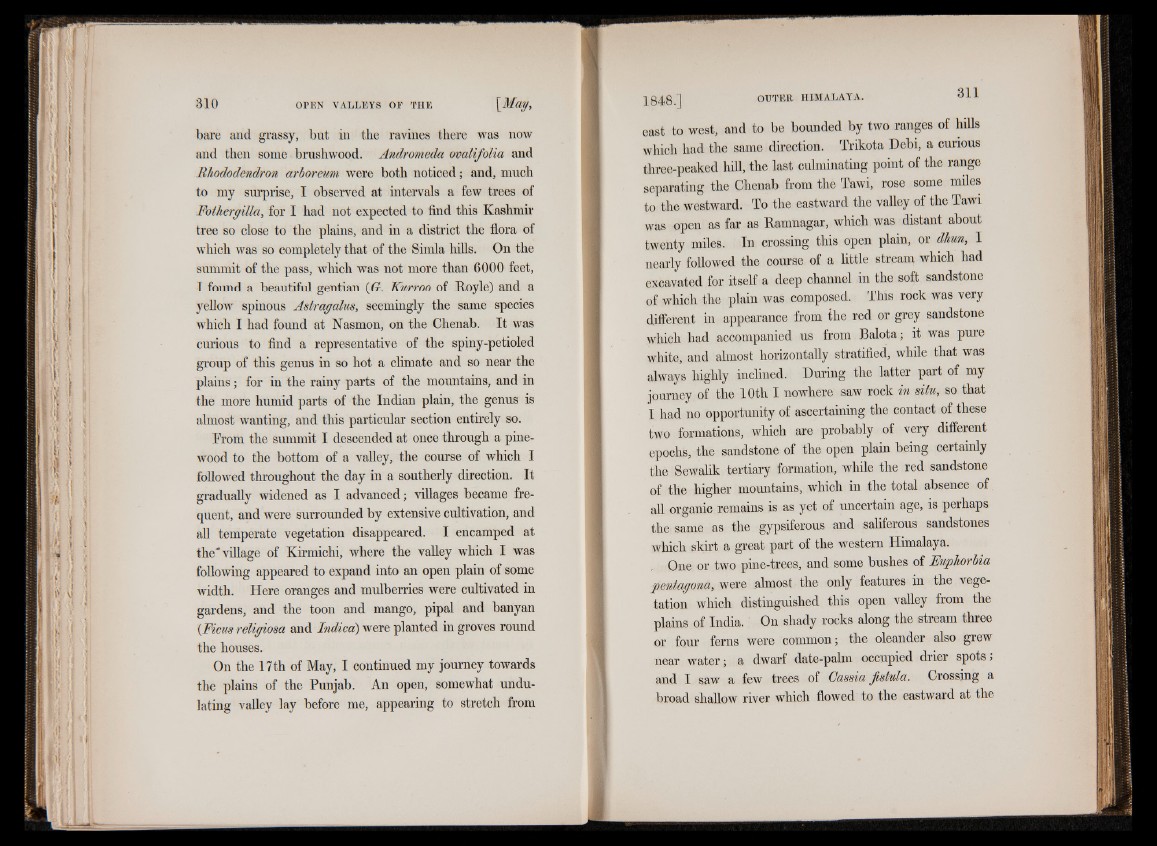
bare and grassy, but in the ravines there was now
and then some brushwood. Andromeda ovalifolia and
Rhododendron arhoreum were both noticed; and, much
to my surprise, I observed at intervals a few trees of
Fothergilla, for I had not expected to find this Kashmir
tree so close to the plains, and in a district the flora of
which was so completely that of the Simla hills. On the
summit of the pass, which was not more than 6000 feet,
I found a beautiful gentian (G. Kurroo of Royle) and a
yellow spinous Astragalus, seemingly the same species
which I had found at Nasmon, on the Chenab. It was
curious to find a representative of the spiny-petioled
group of this genus in so hot a climate and so near the
plains; for in the rainy parts of the mountains, and in
the more humid parts of the Indian plain, the genus is
almost wanting, and this particular section entirely so.
From the summit I descended at once through a pine-
wood to the bottom of a valley, the course of which I
followed throughout the day in a southerly direction. It
gradually widened as I advanced; villages became frequent,
and were surrounded by extensive cultivation, and
all temperate vegetation disappeared. I encamped at
the" village of Kirmichi, where the valley which I was
following appeared to expand into an open plain of some
width. Here oranges and mulberries were cultivated in
gardens, and the toon and mango, pipal and banyan
{Ficus religiosa and Indica) were planted in groves round
the houses.
On the 17th of May, I continued my journey towards
the plains of the Punjab. An open, somewhat undulating
valley lay before me, appearing to stretch from
east to west, and to be bounded by two ranges of hills
which had the same direction. Trikota Debi, a curious
three-peaked hill, the last culminating point of the range
separating the Chenab from the Tawi, rose some miles
to the westward. To the eastward the valley of the Tawi
was open as far as Ramnagar, which was distant about
twenty miles. In crossing this open plain, or dhun, I
nearly followed the course of a little stream which had
excavated for itself a deep channel in the soft sandstone
of which the plain was composed. This rock was very
different in appearance from the red or grey sandstone
which had accompanied us from Balota| it was pure
white, and almost horizontally stratified, while that was
always highly inclined. During the latter part of my
journey of the 10th I nowhere saw rock in situ, so that
I had no opportunity of ascertaining the contact of these
two formations, which are probably of very different
epochs, the sandstone of the open plain being certainly
the Sewalik tertiary formation, while the red sandstone
of the higher mountains, which in the total absence of
all organic remains is as yet of uncertain age, is perhaps
the same as the gypsiferous and saliferous sandstones
which skirt a great part of the western Himalaya.
One or two pine-trees, and some bushes of Euphorbia
pentagona, were almost the only features in the vegetation
which distinguished this open valley from the
plains of India. On shady rocks along the stream three
or four ferns were common; the oleander also grew
near water; a dwarf date-palm occupied drier spots >
and I saw a few trees of Cassia fistula. Crossing a
broad shallow river which flowed to the eastward at the